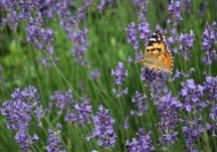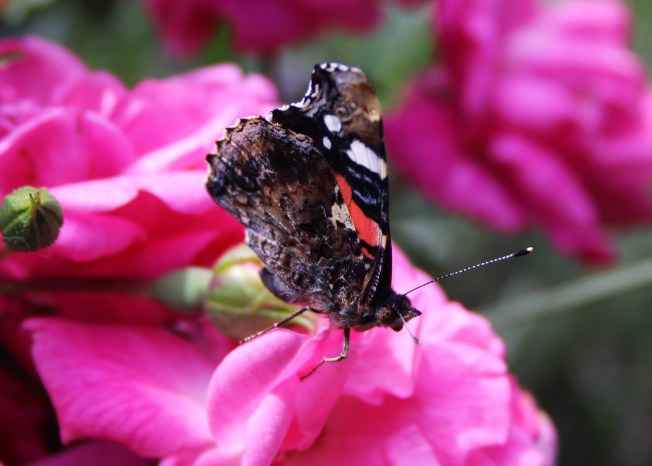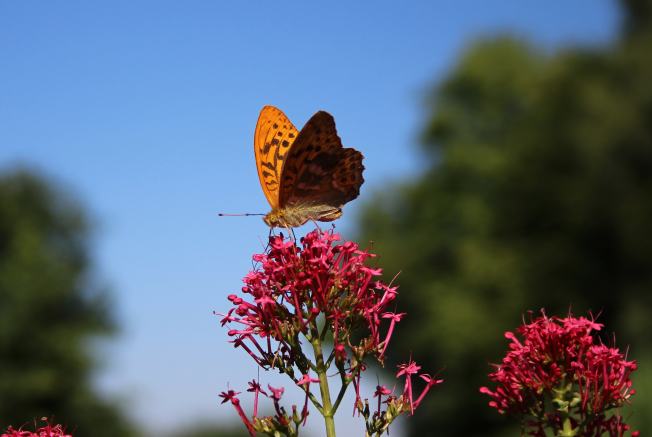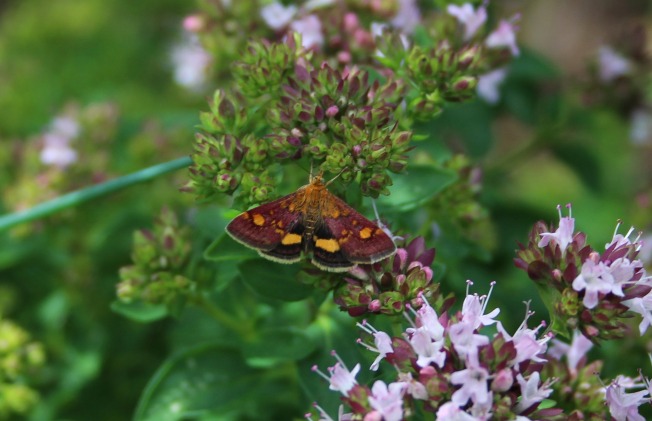
Swallowtail 2012
“I dance above the tawny grass
In the sunny air,
So tantalized to have to pass
Love everywhere
O Earth, O Sky, you are mine to roam
In liberty.
I am the soul and I have no home,
Take care of me.”
From The Butterfly, by Alice Archer (Sewall) James
~~~
Since March this year I have been carefully recording the butterflies, along with a few other beautiful winged creatures, that have visited my garden or the meadow just beyond my garden gate. This month I have again seen many regular visitors; Tortoiseshells, Meadow Browns, Common Brimstones, the occasional Blue, and of course the Small and Large Whites, which despite their profusion have been practically impossible to photograph due to their incessant fluttering!
~~~
Last month I posted a photo of the Red Admiral (Vanessa atalanta, Admiral) with its wings closed. At the beginning of this month a couple were regular visitors to the garden again and rested with open wings for longer periods…

~~~
An unnamed Verbena (maybe someone out there knows which one it is!) attracted this Small Pearl Bordered Fritillary (Boloria selene, Braunfleckige Perlmutterfalter)…

There are so many similar fritillaries, so if anyone spots I have made an error please let me know, but the Small Pearl Bordered is one of the most common ones in our region – actually fairly large with a wingspan of about 3-4cm. Like other fritillaries, the main foodplant is violets. The second generation caterpillars drop to the ground beneath their foodplant for protection in winter and remain hidden until spring, only then forming a chrysalis.
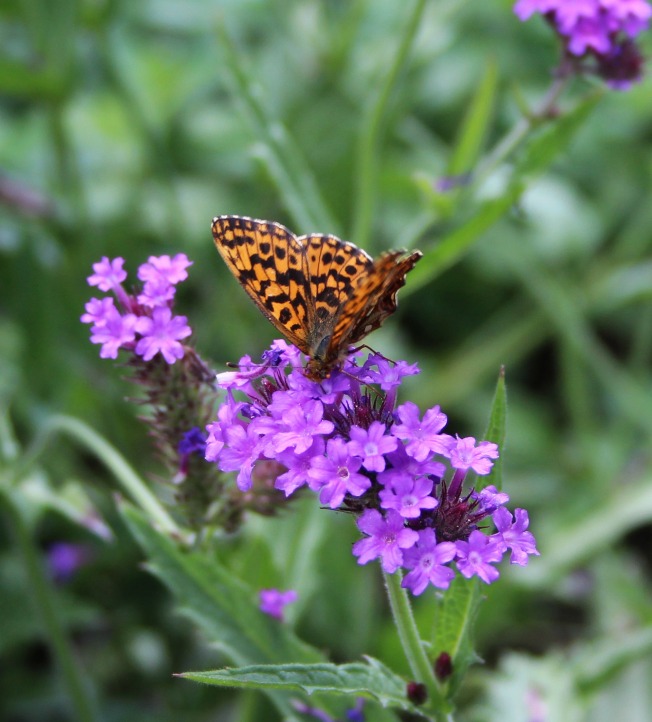
~~~
Another Fritillary, perhaps a High Brown Fritillary? (Fabriciana/Argynnis adippe, Feurige Perlmutterfalter)

~~~
The oregano and marjoram plants have been particularly favoured by the Meadow Browns featured last month, as well as this butterfly; the Map (Araschnia levana, Landkärtchen). The wings when closed explain the name it has been given, with a network of lines…

And the upper side of the wings (see below) does also remind me of the colours found on old maps. This one is a second generation one – the early spring ones, which I haven’t seen here, are more colourful with a lot more orange on the upper wing. Apparently the Map is only seen in central and eastern Europe, and not in the UK. Have you ever seen one?

The Map lays its eggs on nettles and prefers the edges of woodland as its habitat. There humidity is higher and there is some shade for the larvae/caterpillars, while the adults can then fly beyond the woods into sunny areas with nectar-rich flowers.
~~~
The Hummingbird Hawk-moths (Macroglossum stellatarum, Taubenschwänzchen) have been visiting the Centranthus since it opened in May and although there have been phases with fewer numbers, I’d say I have never seen so many as in this summer. The early spring warmth must have suited them.

The early ones were small (only 3cm wingspan) and flew very fast, but as the year progressed they became larger and very slightly slower – acoording to Wikipedia 70 to 90 wingbeats per second! Other interesting facts: the proboscis is about 2cm long and they can fly backwards! As our climate has slowly got milder they now overwinter in most of central Europe, but many still migrate quite far north. Do let me know if you’ve seen one or even several this year. The ones visiting us may be both those that have overwintered and migratory ones. The second generation appears mid-August.

They fascinate me with their tiny fat soft bodies and distinct faces and I love having them brush past me while working in the rockery.
~~~
Apart from a very brief glimpse of a Bedstraw Hawk-Moth (Hyles gallii, Labkrautschwärmer) the only other hawk moth I have seen this year is the Broad-bordered Bee Hawk-moth, (Hemaris fuciformis, Hummelschwärmer)…

Beautiful creatures!
This one has a slightly larger body than the Hummingbird Hawk-moths, but the wingspan is about the same – around 4 to 5 cm. From the information on the German Wikipedia page (the English one is minimal!) I assume we have two generations here, and they overwinter here too. The foodplants include all Lonicera, as well as Galium, Deutzia, Knautia and – to my surprise – Cephalaria, which I recently put on my autumn planting list after seeing it in Janet’s garden (Plantaliscious). 🙂 They are found in open woodland and chalk hills with conifers and shrubby honeysuckles – precisely what our region offers.
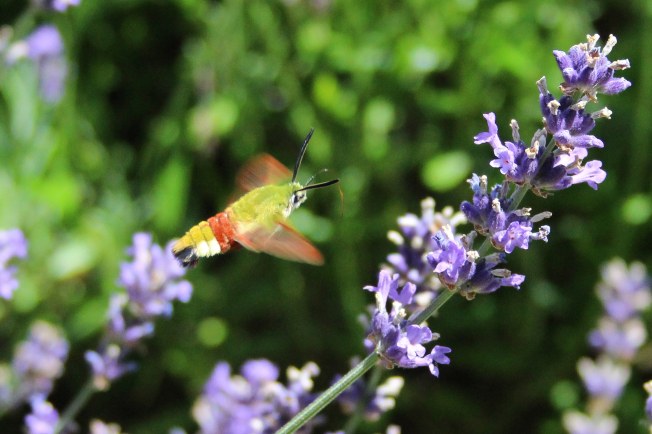
Other hawk-moths I have seen in previous years were the Small Elephant Hawk-moth (Deilephila porcellus, Kleiner Weinschwärmer) and the Bedstraw Hawk-moth (Hyles gallii, Labkrautschwärmer), which I posted about in 2012 here.
~~~
Mid-month my neighbour brought me a caterpillar to identify: a Pine Hawk-moth (Sphinx pinastri, Kiefernschwärmer). It was about 7cm long and very lively!

After looking it up I thought the actual moth looked familiar. In early June I took a photo of a large grey moth with black markings, then promptly forgot about it…. here it is: the Pine Hawk Moth…

Not as impressive as the caterpillar, but still rather pretty markings. This one was about 10cm long, but I didn’t see its wings open. The adults lay the eggs on pine needles or other conifers, and are seen between May and June, and then again in August. I imagine our caterpillar will overwinter in its chrysalis then.
~~~
While looking through old photos from June to find the Pine Hawk-moth, I also discovered this picture which I had totally forgotten about as well: a Five-spot Burnet (Zygaena trifolii, Sumpfhornklee-Widderchen). I shall include it here and add it to my June post too.

The wings are almost black, tinged blue, with those distinctive red spots. I have since learned that the foodplant is Bird’s-foot Trefoil – another excuse not to do the weeding!
😉
~~~
I glimpsed the elusive Swallowtail butterfly floating elegantly across the lawn, but the photo at the top of this post was taken 2 years ago. There’s still time yet, and a Swallowtail caterpillar on the fennel provides hope!

~~~
There is still another butterfly month left – maybe even two – so I shall be keeping my eyes peeled and will report once again at the end of September.
🙂
What visited your garden in August? Any unusual guests?




